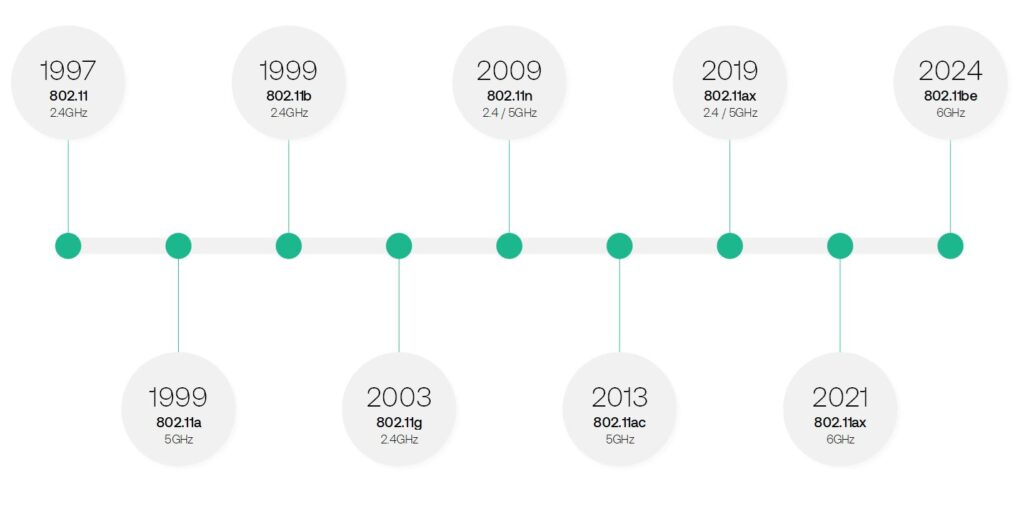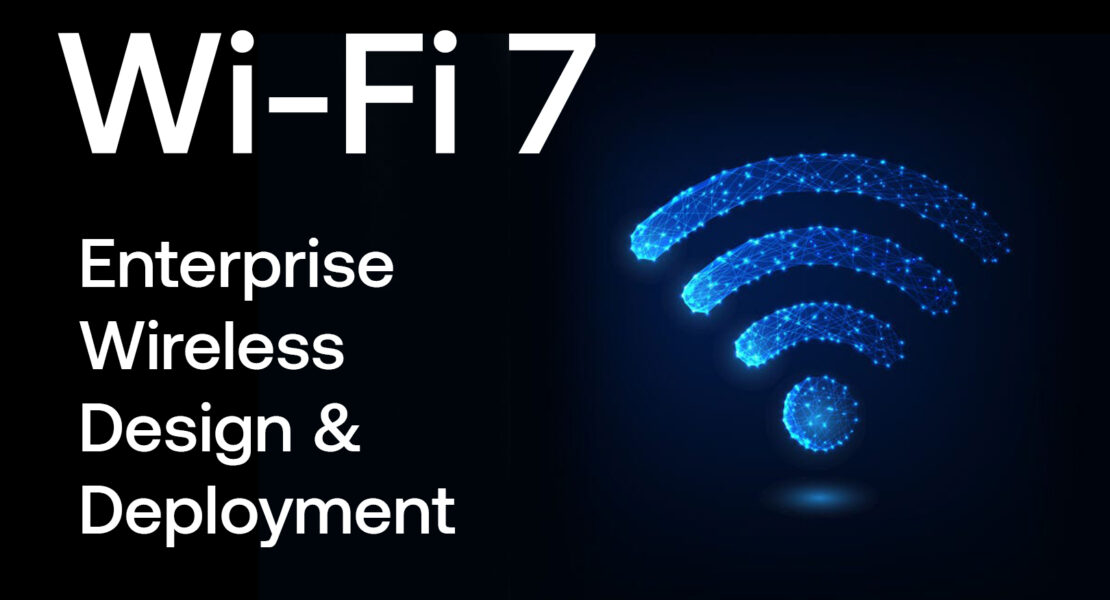Wi-Fi 7 & Your Enterprise Network
Building on the advancements of Wi-Fi 6 and 6E, Wi-Fi 7 aims to deliver even faster speeds. But what is the impact Wi-Fi 7 will have on the deployment of your enterprise network?
In this article, we explore the features of Wi-Fi 7, outline key design considerations for Wi-Fi 7, and provide guidance on how to ready your enterprise network for the years to come.
Wi-Fi’s Evolution: From 2 Mbps to Wi-Fi 7
Wi-Fi has come a long way since 1997, starting with the 802.11 standard that provided basic wireless connectivity at 2 Mbps on the 2.4 GHz band. Over the years, each new iteration brought faster speeds and better reliability. Now, Wi-Fi 7 (802.11be), is promising even faster connections, lower latency, and better performance!

Wi-Fi 7 in Australia
In early 2024, the Wi-Fi Alliance introduced Wi-Fi 7 – 802.11be Extremely High Throughput. While this has yet to be certified by the Institute of Electrical and Electronics Engineers (IEEE), the amendment bolsters the advancements made in Wi-Fi 6E and promises speeds of 40Gbps+ by adopting a range of new features.
As with the release of 5GHz Wi-Fi, Australia will have a slightly different implementation than our United States counterparts. Australia has a comparatively limited allocation of the 6GHz spectrum compared to the United States. This will mean a reduction in how useful some of the new Wi-Fi 7 features are – particularly in anything larger than home office deployments. However, there are some key functions that we believe will impact enterprise wireless design and deployment.


Wi-Fi 7 Key Functions
Multilink Operation
Something we’re particularly excited about is MultiLink Operation (MLO). MLO will enable supported devices to utilise more than one wireless frequency at a time, steering end devices to use the frequency experiencing less congestion. This is done on a per-packet basis and aims to achieve <1ms of latency.
With MLO, we can expect more consistent and stable wireless network connections which is key for clinical mobile handsets and medical monitoring devices throughout healthcare systems. MLO also promises less lag for time-sensitive systems and equipment like Audio Visual endpoints.
Puncturing
Introduced as optional in Wi-Fi 6, but now improved and mandatory in Wi-Fi 7, puncturing helps to provide a more efficient wireless network in dense and noisy environments. Puncturing aims to maintain the effectiveness of the wireless network and assists to deliver more bandwidth in denser environments that contain multiple wireless networks such as enterprise office buildings, multi-tenant spaces, and convention spaces.
Previously, when a segment (subchannel) of a bonded channel experienced interference, the channel would need to move, or the number of subchannels reduced to avoid the interference. Puncturing in Wi-Fi 7 carves out the subchannel with interference and allows users to continue to use the bonded channel.

4K QAM
Quadrature Amplitude Modulation (QAM) has been part of the 802.11 standard for quite a while, however 802.11be brings with it 4K QAM. This will deliver a 20% increase in data rate on the 1024-QAM featured in 802.11ax, although with a big caveat. To achieve this increase in data rate your wireless environment would need to be absolutely pristine – likely needing a Signal to Noise Ratio (SNR) of 40dB or better.
While this won’t be beneficial for most users, certain specialised cases that combine 4k QAM with other Wi-Fi 7 improvement such as MLO and 320MHz channels may be provide a substantial benefit. Engineering and scientific research spaces, where high data throughput is required, while maintaining some level of mobility at the end device, could certainly make use of 4K QAM.
320MHz Channels
Another improvement in 802.11be on its predecessor is 320MHz bonded channels using the 6GHz spectrum – a doubling from 802.11ax’s 160MHz channels. This will enable 16 standard 20MHz channels to be combined (bonded) into one, increasing throughput. The drawback in Australia being that only one 320MHz can be implemented due to our spectrum allocation from the Australian Communications & Media Authority (ACMA). While this might be useful for single Wireless Access Point deployments, there will be limited use-cases for the enterprise with the current restrictions on the 6GHz spectrum.
We’ll be interested to see the use-cases come through for 320MHz channels. The potential for higher data rates will have many assessing the technology at home and in test environments.
Wi-Fi 7 Design Considerations and Future Proofing
Check yo’ self before you WAP yo’ self – Ice Cube
Often when it comes to enterprise network design, we aim to create a future proof solution that meets the needs of users. Wi-Fi 7, allowing for higher data rates, makes the technology appealing for supporting emerging technologies like augmented reality and virtual reality with high data requirements.
However, there are a number of design nuances that must be considered when deploying a Wi-Fi 7 solution to an enterprise environment. Notable considerations include:
- 6GHz doesn’t travel quite as far as 5GHz
- Free Space Path Loss (FSPL) is 49dB in the first meter, and an additional 6dB loss for every doubling of distance thereafter. 47dB for 5GHz and 40dB for 2.4GHz FSPL in the first meter.

- Indoors, 6GHz WAPs will have a maximum of 24dBm EIRP. They will be known as Low Power Indoor (LPI) Access Points. Outside of Australia, this limitation is often different.
- Outdoors, Very Low Power (VLP) Access Points will have a maximum of 14dBm EIRP. Again, this is within Australia and regulated by the ACMA
- 6GHz Access Points are to have integrated antennas only – no external antennas. This has major implications for the design of Wi-Fi through outdoor areas.
- PoE+ will be required to power these Access Points at a minimum. Wired network design and server room design will play a big impact on whether or not your organisation can deploy a Wi-Fi 7 capable wireless network
- Double check your Access Points – do they cater for all three bands? And if they do, are you sure that you need them to?
- Consider leaving the 6GHz spectrum for SSIDs that need it. Is your priority your guests, your medical equipment, or maybe your CTO? The prioritisation of wireless traffic during the design stage is key for meeting user expectations following deployment
And remember – 60% of all Wi-Fi traffic is control frames. 15% is management frames. That’s only 25% left for data!
If your organisation is looking to deploy a Wi-Fi 7 solution, we recommend engaging a suitably qualified and experienced technology design consultant to guide you through this process, and provide you with an understanding of the suitability of the technology for your organisation.
If you require assistance navigating the complexities of technology design and integration, please don’t hesitate to contact our consulting team at: +61 3 9601 6555.


